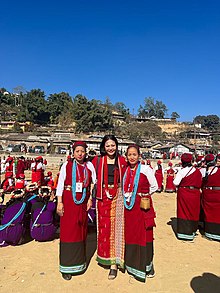|
Tagin people
The Tagins are one of the major tribes of Arunachal Pradesh, India, a member of the larger designation of Tani Tribes. The Tagins refers to a tribe of Northeast India Region. The Tagins are members of the larger designation of Abotani (abo - 'father', tani - 'ancestor's name'). Most Tagin are adherents of Donyi-Polo, with a Christian minority. DistributionTagins are the dominant tribe in Upper Subansiri district.[2] They are also found dispersed in the adjoining districts, especially in West Siang, Papum Pare, in Arunachal Pradesh, as well as some areas of Tibet adjacent to Arunachal Pradesh. PopulationAccording to 2011 census there are 62,931 Tagin people in India. A few thousand in Tibet is expected. There are many clans among the Tagins, for example, Duchok, Mosing-Mosu, Tamin (Nakam, Nayam, Neva, Negia Nutik, Mindi (Nasi & Nalo) and Japo), Leyu, Reri, Natam-Gyadu (Bagang), Nah, Gyama, Tache-Tagia, Tasi, Dui, Topo, Tani-Tator, Cherom-Chera, Buning, Heche, Kodak-Konia, Nalo, Pombu, Bagang (Nacho, Naji, Singming, etc.), Aiyeng (Payeng), Paji, Gumsing, Kojum Abu, among others. LanguageTagin people speak their own local dialect which is Tagin. Although there are tonal variations among them, these variations causes no hurdle in understanding each other. ReligionOriginally the traditional Si-Donyi as a religion was being followed all around. Si-Dyoni derives from ‘Si’ ('Earth'), and ‘Dyoni’ ('Sun'), which follows the cult of animism and ritualistic nature worshiping in the form of spiritual deities where particular kind of animals or chickens are sacrificed at the altar (yogging-made out of the bamboos and wooden leaves with particular leaves or vines in stuffed shape) to please the spirits, more likely not anger them and keep them in their kind form. Priest or Nyibu shaman who are born with their powers are the ones who communicate and negotiate between the other world. They are the in-between messenger from this world to other world. FestivalsThe most important festival of the Tagins is the Si-Donyi Festival, which involves the god of the earth (si) and the goddess of sun (donyi).[3] Si-Donyi is celebrated from 3 to 6 January every year. It is celebrated for the well-being of mankind with the coming new year where the nyibu (local priest) presides over and performs all the rituals with chanting of Uuyu Benam (celestial chants). And sacrifice of Mithuns before the god-goddess for peace and prosperity in the community as a whole. OrganisationsTagin Cultural Society (TCS) and Tagin Welfare Society (TWS) are the main parental organisation of the tribe. There are also youth/student groups called All Tagin Students Union (ATSU) and All Tagin Youth Organisation (ATYO). The TWS or TCS also have many subgroups, and have been helping in shaping the future of the state. References
Bibliography
|
||||||||||||||||||||||||||||||
